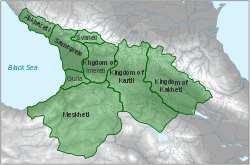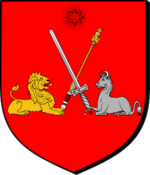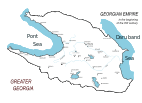Kingdom of Kartli
| Kingdom of Kartli | ||||||||||
| ქართლის სამეფო | ||||||||||
| Kingdom | ||||||||||
| ||||||||||
|
| ||||||||||
 Kingdom of Kartli in 1490 | ||||||||||
| Capital | Tbilisi | |||||||||
| Languages | Georgian | |||||||||
| Religion | Georgian Orthodox Church | |||||||||
| Political structure | Kingdom | |||||||||
| King | ||||||||||
| • | 1466–1478 | Bagrat VI of Georgia (first) | ||||||||
| • | 1744–1762 | Teimuraz II (last) | ||||||||
| Historical era | Early modern period | |||||||||
| • | Established | 1466 | ||||||||
| • | Subject of Persia | 1555-1747 | ||||||||
| • | Union of Kartli and Kakheti | 1762 | ||||||||
| • | Disestablished | 1762 | ||||||||
| ||||||||||
| Today part of | Countries today
| |||||||||
| History of Georgia |
|---|
 |
|
History by topic |
|
|
The Kingdom of Kartli (Georgian: ქართლის სამეფო) was a feudal Georgian state that existed from 1466/84 to 1762, with the city of Tbilisi as its capital. Through much of this period of time the kingdom was a vassal of the Persian empire, but enjoyed intermittent periods of greater independence, especially after 1747.
History
In the 15th century, after a long economical and political decline, Georgia became neighbors with the increasingly volatile and aggressive Ottoman Empire, and from the 16th century with the Safavid Empire, causing the kingdom to be in a state of almost constant war or ruled by the Persians for the entirety of its three centuries of existence.
Georgia experienced a high degree of civil instability, feudal separatism, and civil wars. The defeat of George VIII in the Battle of Chikhori against rebellious noble Bagrat, who proclaimed himself the King of Imereti, marked the beginning of the final disintegration of united Georgian monarchy and the state. In 1465, George VIII was captured by Kvarkvare II Jaqeli the Atabeg of Samtskhe. Sensing opportunity, Bagrat VI immediately proclaimed himself King of Kartli as well and took control of it in 1466. Kvarkvare, fearing that Bagrat would gain too much power, released George VIII from captivity, but the king was unable to reclaim the crown and only managed to proclaim himself King of Kakheti, creating even more fragmentation.
Bagrat VI continued to rule Kartli until 1478, when he was challenged by yet another pretender to the throne, Constantine II. Inter-feudal strife continued even during the reign of Constantine, who lost the Battle of Aradeti with Kvarkvare in 1483, with Alexander son of Bagrat VI proclaiming himself as the king of the all Western Georgia in 1484. The attempts of Constantine II, in 1489, to restore his rule over united kingdom of Kartli-Imereti were unsuccessful. In 1490, he was finally forced to recognize the splitting of Georgian kingdom into kingdoms of Kartli, Imereti, Kakheti and the Principality of Meskheti.
The new realms were not long at peace. Soon after coming into power, George II of Kakheti launched an expedition against Kartli, intending to depose King David X and conquer his kingdom. David's brother Bagrat successfully defended the kingdom and managed to capture George II in an ambush. Peace didn't linger in the west either, as David X faced incursions from Alexander II of Imereti, who was somewhat less successful than his Kakhetian counterpart. In 1513 the Kingdom of Kartli conquered Kakheti but only for a short time – the Kingdom of Kakheti was restored with the support of local nobles by Levan of Kakheti, son and heir of George II, in 1520.[1]
From the mid-16th century till 1762, Kartli stayed under intermittent Persian rule and was an integral part of their various dynasties. It regularly paid tribute and sent gifts (pīškeš) to the shah in the form of boys and girls for use as slaves, horses, and wines.[2] However, in 1747 the Shah of Persia, Nader Shah was assassinated during a rebellion, and under the energetic king Erekle II, Kartli and the neigbouring kingdom of Kakheti declared de facto independence and were unified into the short-lived Kingdom of Kartli-Kakheti. Following the Treaty of Georgievsk and the sack of Tblisi by Agha Mohammad Khan, in 1801 the Kingdom of Kartl-Kakheti was annexed to the Tsarist Russian Empire. Russian suzerainty over Kakheti and the rest of Georgia became finalised with Qajar Iran in 1813 with the Treaty of Gulistan.[3]
See also
References
- ↑ Georgian Soviet Encyclopedia, Vol. 10, pg. 466–469, Tb., 1986
- ↑ Berdzenishvili, ed., 1973, pp. 252–254
- ↑ Timothy C. Dowling Russia at War: From the Mongol Conquest to Afghanistan, Chechnya, and Beyond p 728 ABC-CLIO, 2 dec. 2014 ISBN 1598849484


